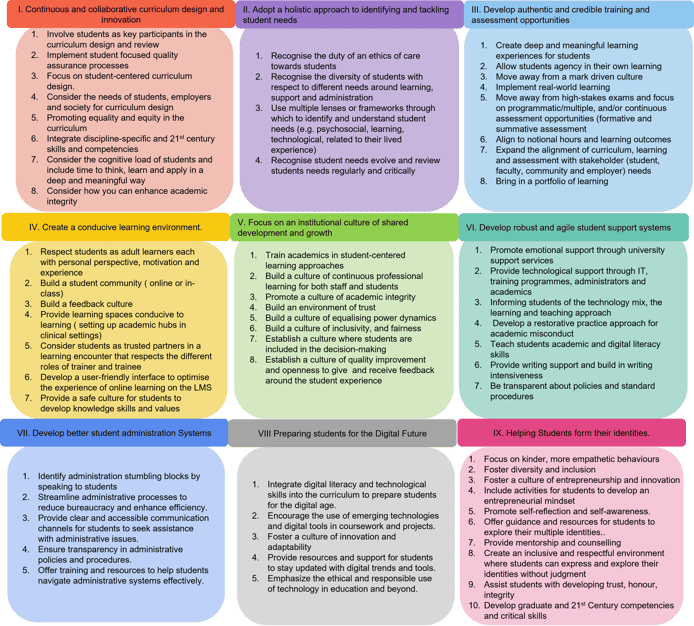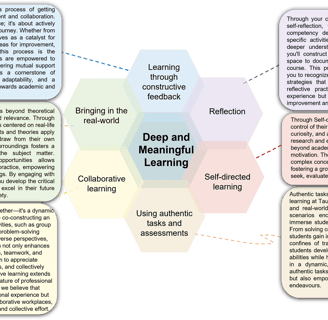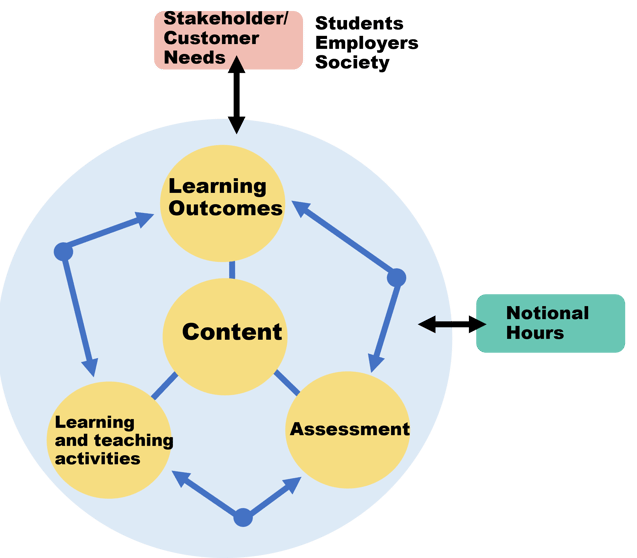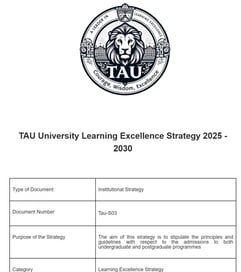The TAU University Commitment to Learning Excellence
What we strive for with Learning Excellence?
At Tau, we understand that your university experience is about more than just earning a degree—it's about your personal growth and development. That's why we're dedicated to providing you with the best learning experience possible, tailored to your individual needs and aspirations.
Learning excellence, to us, means creating an environment where quality learning thrives. It's about more than just traditional teaching methods—it's a holistic, student-centered approach that prepares you not only academically, but also personally and professionally for the complexities of the modern world. Our approach to learning excellence is multidimensional, integrating deep and meaningful learning experiences, active teaching strategies, and the development of critical and 21st-century skills.
We foster a culture of learning that encourages innovation, equality, and the development of your personal, professional and student identities.
Here's what learning excellence looks like at TauU:
Ethics of Care and Inclusivity: We prioritize the diverse needs of our students, promoting inclusivity, respect, and a sense of belonging.


Student-Centered Curriculum Design: Our curricula are designed with you in mind, incorporating real-world problems and hands-on experiences to keep learning engaging and relevant.
Deep and Meaningful Learning: We go beyond academic knowledge to develop critical thinking, creativity, and problem-solving skills through reflective learning and authentic tasks.
Active Learning: We encourage you to take an active role in your education through discussions, group work, and collaborative activities.
Learning Technologies Integration: We leverage technology to enhance your learning experience, providing you with valuable skills for the digital age.
Continuous Improvement and Stakeholder Engagement: We're committed to ongoing evaluation and enhancement based on feedback from students, faculty, and other stakeholders.
Flexibility in Learning: We offer flexible programs and scheduling options to accommodate your needs and allow you to take control of your education.
Creating a Culture That Supports Learning: We foster an environment of mutual respect, open communication, and collaboration where curiosity is nurtured and failures are viewed as opportunities for growth.
Creating a Safe Environment: We prioritize your mental and emotional well-being, ensuring a supportive and respectful atmosphere free from discrimination and harassment.
Continuous Personal Development and Lifelong Learning: We encourage you to view education as a lifelong journey, providing opportunities for professional development and personal growth.
Real-world Learning and Work Experience: We integrate internships, co-op placements, and project-based learning to provide you with hands-on experience and enhance your employability.
At Tau, learning excellence is more than just a goal—it's a commitment to your success and well-being. Join us on the journey to excellence in learning and personal growth.
Deep and Meaningful Learning
At TAU, we prioritize deep and meaningful learning, employing a robust framework that enriches our courses and empowers students to excel. Our Deep and Meaningful Learning (DML) approach is multifaceted, requiring students to actively engage in their learning journey. Firstly, students are encouraged to reflect on their learning and construct a portfolio of their progress, fostering self-awareness and personal growth. Additionally, our culture of feedback ensures that both academics and students provide valuable insights, enhancing learning outcomes.
Moreover, students are empowered to direct their learning, conducting research and finding resources to fuel their curiosity and motivation. We emphasize authentic tasks and activities over traditional exams, allowing students to apply their knowledge in practical contexts and develop real-world skills.
Collaborative learning is also central to our approach, as we believe that shared understanding and teamwork lead to deeper comprehension and communication skills. Lastly, real-world learning experiences, including case studies and work experiences, connect academic concepts to tangible, real-life situations, making learning more relevant and impactful.
At TAU, deep and meaningful learning is not just a goal—it's a transformative experience that prepares students for success in both academia and the professional world.


Constructive Alignment: Designing for Excellence
At TauU, our commitment to transformative education begins with intentional design. We believe learning doesn’t start at the point of delivery—it starts with purpose. That’s why we champion constructive alignment, a teaching and curriculum design framework that ensures every element of a programme is deliberately interconnected and aligned with real-world relevance.
What Is Constructive Alignment?
Constructive alignment, as described by Biggs (2014), is a learner-centered approach where we begin by clearly articulating what students are expected to learn (learning outcomes) and how they will demonstrate that learning (assessment tasks)—before teaching even begins. We then design learning activities that maximise students’ opportunities to achieve those outcomes.
“Learning takes place through the active behavior of the student: it is what he does that he learns, not what the teacher does.” – Tyler, 1949
This principle repositions the teacher’s role—from knowledge transmitter to designer of learning experiences that actively engage students in constructing their own understanding. The alignment between outcomes, assessments, and activities becomes the backbone of quality education.
Why It Matters at TauU
Constructive alignment ensures that learning is intentional, transparent, and impactful. But at TauU, we take it further.
We believe that constructive alignment is broader than simply connecting outcomes, teaching content, and assessments. It should begin not at the curriculum level, but with alignment to stakeholder needs (van As, Pentz & Cooke, 2024). This means first understanding the current and future knowledge, values, and competencies required by employers, society, and students—both in their personal and professional development. From this foundation, we design programme outcomes, then develop course outcomes, and finally align teaching and assessment to these.


We also pay close attention to the notional hours allocated, ensuring a healthy balance between content delivery and time to think, reflect, create, and practice. True competence doesn’t emerge from passive instruction—it is built through deliberate time to engage deeply.
At TauU, we draw on real-time insights from data science, skills mapping like the World Economic Forums work on the Global Skills Taxonomy, and continuous engagement with industry, students, and communities to ensure our curriculum remains relevant and dynamic.
Our Process
Stakeholder-Driven Design
We begin with deep listening: What knowledge, values, and competencies do our communities, employers, and students need? What do future employers expect? What do students aspire to?
Outcome-Led Curriculum Development
From those needs, we craft programme and course outcomes that are purposeful, future-focused, and responsive to a changing world.
Aligned Teaching and Assessment
Learning activities and assessment tasks are aligned with these outcomes to ensure coherence and relevance. We integrate authentic tasks and apply the Deep and Meaningful Learning Framework to ensure students have structured opportunities to think, reflect, and do.
Continuous Feedback and Adaptation
Our alignment doesn’t end at design. We embed continuous feedback loops, leverage learning analytics, and use learner experience data to enhance our programmes and stay adaptive in an evolving landscape.
The Impact
Constructive alignment brings clarity to students, empowers educators, and leads to quality outcomes that matter. It transforms education into a cohesive, learner-centered journey—where students understand not only what they are learning, but why it matters.
This is not just pedagogy—it’s our promise. At TauU, constructive alignment is how we translate our vision of learning excellence into a meaningful reality.
Figure 1: Extended definition of constructive alignment (van As, Pentz & Cooke, 2024)
References
Biggs, J. (2014). Constructive alignment in university teaching. HERDSA Review of Higher Education, 1, 5-22.
Tyler, R.W. (1949). Basic principles of curriculum and instruction. Chicago: University of Chicago Press.
University of Tasmania. (n.d.). Constructive alignment. Teaching and Learning. https://www.teaching-learning.utas.edu.au/unit-design/constructive-alignment
van As, J., Pentz, S., & Cooke, R. (2023). Towards deep and meaningful learning: Shaping culture, designing curricula, and considering student needs. In Reimagining South African higher education: Towards a student-centred learning and teaching future (Chapter 1). African Sun Media. https://doi.org/10.52779/9781991260468/01

The flexibility of Tauu's programs made my education journey incredibly convenient and manageable with my lifestyle.
Alex Smith

I appreciate how Tauu's blended learning allows me to balance work and family commitments seamlessly.
Jamie Lee





